Contact us today:

(847) 934-4500
tdaro@bernardandcompany.com

Contact us today:
(847) 934-4500
tdaro@bernardandcompany.com
As an industry #ANCATooloftheYear celebrates the knowledge and imagination of cutting tool craftsmen, creating tools with the perfect geometry, profile, and finish that shape and build our world everyday.
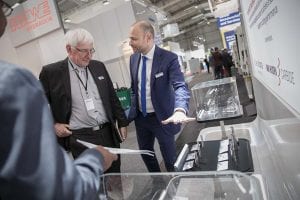 KV Tooling took out the coveted first place in ANCA’s industry first competition, ‘ANCA Tool of the Year’. The cutting tool industry has cultivated and refined their craft over the years to design beautiful tools, applying science to achieve a sub-micron surface finish and superior cutting performance.
KV Tooling took out the coveted first place in ANCA’s industry first competition, ‘ANCA Tool of the Year’. The cutting tool industry has cultivated and refined their craft over the years to design beautiful tools, applying science to achieve a sub-micron surface finish and superior cutting performance.
Pat Boland, ANCA Co-founder said “All finalists were of a very high standard and demonstrated a deep understanding for tool geometry as well as taking full use of ANCA’s software to design unique and special cutting tools. We congratulate the winner KV Tooling, runner up Eshed Tools and Zakłady Mechaniczne Kazimieruk who we gave a special creativity award for daring Bat Man design.”
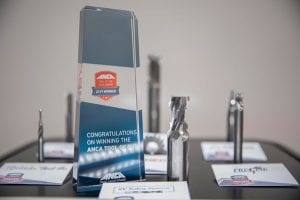 Brian Beland, President at KV Tooling Systems said on winning the award: “Competing with world class tool grinding shops from around the world with same grinding machines and winning – regardless of the size of the shop – is something we are particularly proud of.”
Brian Beland, President at KV Tooling Systems said on winning the award: “Competing with world class tool grinding shops from around the world with same grinding machines and winning – regardless of the size of the shop – is something we are particularly proud of.”
“Our entry was a very complex tool with many features incorporated into one tool. We designed the cutting tool to satisfy a customer’s problem, where our one tool replaced a machining requirement that previously required six tools. The customer was very happy with the production gains and for us to submit to ANCA Tool of The Year. We believe winning the competition makes our company more marketable and will give us great exposure and hopefully expand our customer base,” concluded Brian.
Eshed Tools entered the competition to share their special tool manufacturing skill set with ANCA users. Shmulik Arbel, Production Manager commented that they were proud of their expertise that means they can “produce special geometries that are difficult to achieve and save our clients expensive production time.”
Reflecting on coming runners up Shmulik continued, “Taking out this prize creates a great opportunity for global exposure through the Tool of the Year competition. For us ESHED tools as a small and growing tool manufacturer, world wide recognition is important and will help us expand beyond the local market.”
Zakłady Mechaniczne Kazimieruk on winning the ‘Most Creative Tool’ said: “We thought outside the box and were motivated to inspire the grinding community with our entry. During everyday work our team make a lot of customized tools so we wanted to make something fresh and unique – even to us. Furthermore, entering was a great test for our grinding skills. We relished the opportunity of seeing others craftmanship and the entries in the tool of the year competition demonstrated to us the range and type of cutting tools that are possible.”
The competition was based on the passion and the craft of tool making and celebrate our highly skilled tool grinding community. Watch the live announcement of winners at EMO 2019:
Judging Panel
The top five tools were judged on the following criteria:
For further information, please visit:
https://machines.anca.com/Contact
ANCA is a market leading manufacturer of CNC grinding machines. It was founded in 1974 in Melbourne, Australia where the company still has its global headquarters. ANCA has offices in the UK, Germany, China, Thailand, India, Japan, Brazil and the USA as well as a comprehensive network of representatives and agents worldwide.
ANCA CNC grinders are used for manufacturing precision cutting tools and components across a diverse range of competitive industries including cutting tool manufacture, automotive, aerospace, electronics and medical.
Continue reading
Whether mechanical stamping presses or hydraulic composite lines: Digital solutions can improve the productivity of every machine

Sophisticated sensors and actuators in the latest Schuler machines help to prevent potential downtimes. © Schuler
Predicting potential downtime of a press well in advance and thereby improving its availability and productivity? Sophisticated sensors and actuators in the latest Schuler machines make it possible – whether mechanical transfer presses, hydraulic hot stamping or composite lines, for instance. Visitors of this year’s Fabtech November 11-14 in Chicago will find out more at the Schuler booth D46055.
In Schuler presses, machine components can be monitored for changes, wear, and damage to optimize the maintenance process. For this purpose, regular test runs of the system are performed in which vibration data, torque progressions, and energy consumption, among other things, are measured, stored, and compared. Sensors in the press bed and slide record the acceleration per stroke for example, enabling stampers to monitor the forming processes in detail.
The most recent example is the completely redesigned MC 125 stamping press. Thanks to additional integrated sensors, its condition can be fully monitored at all times. This ensures the productivity of the stamping machine. The functionalities are also available on mobile devices.

Schuler’s “Smart Assist” accelerates the production startup by guiding the user step-by-step through the process. © Schuler
However, digital solutions can also help to accelerate the production startup significantly. Schuler’s servo presses come with a software called “Smart Assist” which guides the user through the process step-by-step with the aid of videos and graphics, optimizes the movement curves of the slide and transfer fully automatically, and transfers the data to the overall system. Compared to setting up the system manually, which can take up to eight hours for an expert, the Smart Assist reduces the process to just 30 minutes.
Track & Trace with pinpoint accuracy
Compared to cold forming, significantly more factors influence the production process in hot stamping, which is usually done with hydraulic presses. Here, Schuler’s process monitoring solution records the exact temperature of the red-hot blanks as they leave the furnace, the amount of time that passes before they are placed in the die, the press force applied, and many other things. All of these parameters have a direct effect on the part quality. In case there is any doubt, stampers can track and trace these parts with pinpoint accuracy.
When it comes to composite presses and the production of parts made of carbon fiber reinforced plastic (CFRP), it is all about manufacturing costs. Within the research project “iComposite 4.0,” Schuler and its partners have succeeded in reducing both costs and throughput times for a prototype part dramatically. The production line runs Aachen Center for Integrative Lightweight Production (AZL) of RWTH Aachen University in Germany.
About the Schuler Group – www.schulergroup.com
Schuler offers customer-specific cutting-edge technology in all areas of forming technology – from networked presses to press shop planning. In addition to presses, the product portfolio also includes automation and software solutions, dies, process know-how and service for the entire metalworking industry. Its customers include automobile manufacturers and automotive suppliers, as well as companies from the forging, household appliance and electronics industries. Presses from the Schuler Group mint coins for more than 180 countries. As a provider of innovative system solutions, we support our customers worldwide in the digital transformation of forming technology. In the 2018 fiscal year, Schuler generated sales of € 1 212 billion. Schuler AG, founded in 1839 at its headquarters in Göppingen (Germany), has approx. 6 600 employees at production sites in Europe, China and America as well as service companies in over 40 countries. The company is majority-owned by the Austrian ANDRITZ Group.
For further information on Schuler Inc., North America, please contact:
Guido Broder, Vice President of Sales & Marketing
Schuler Incorporated
7145 Commerce Blvd.
Canton, MI 48187 USA
734-207-7200
Guido.Broder@schulergroup.com

Visit ANCA at EASTEC at booth 1244 to learn more about how our world-first technology developments have helped reduce production costs by 50% through lights out manufacturing
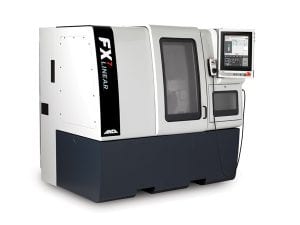 From 3D simulation software to LaserPlus, an in-process measurement system, to RoboTeach, which makes robotic loaders accessible and easy to program – ANCA has been building a tool box of technology for our customers to reap the benefits of automation and Industry 4.0.
From 3D simulation software to LaserPlus, an in-process measurement system, to RoboTeach, which makes robotic loaders accessible and easy to program – ANCA has been building a tool box of technology for our customers to reap the benefits of automation and Industry 4.0.
Visit us at Booth 1244 and learn more about how ANCA is enabling manufacturers to run ‘lights out’ and download our practical guide on how to build a Factory of the Future.
Thomson Mathew, Software Product Manager says: “Get a live demo of the soon to be released ToolRoom RN34 software and learn how it specializes in complex cutting tool geometries for the aerospace, die mould and power generation industry.”
ANCA’s latest ToolRoom RN 34 software release focuses on manufacturing the most complex tool geometries with a perfect balance. Visitors can get a demo of the endmill cycles for ballnose and corner radius, tool balancing and next generation fluting cycles.
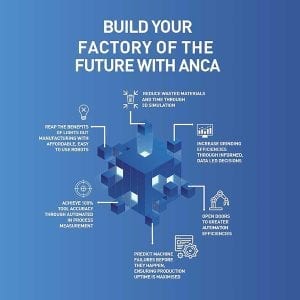 Also at the show will be ANCA’s Management Suite, which either on the premise or in the cloud is a game changer for the CNC grinding industry. It provides customers the technology to monitor the performance of their machines no matter where they are in the world. The new software also enables companies to run smart factories by providing live production information to make data-based decisions on operational improvements. Also launching soon is a new USB WiFi dongle that will add seamless connectivity to machine users.
Also at the show will be ANCA’s Management Suite, which either on the premise or in the cloud is a game changer for the CNC grinding industry. It provides customers the technology to monitor the performance of their machines no matter where they are in the world. The new software also enables companies to run smart factories by providing live production information to make data-based decisions on operational improvements. Also launching soon is a new USB WiFi dongle that will add seamless connectivity to machine users.
Email us at marketing@anca.com to book a free demo at EASTEC 2019 to see ANCA’s latest ToolRoom version or our Management Suite software.
Ideal for light manufacturing, regrinding and full production – see the FX7 Linear at EASTEC
For customers that require increased flexibility or more spindle power, or increased automation capacity that a robot can provide, the FX7 Linear offers these. The FX7 Linear offers a wide range of options for those looking to increase productivity and accuracy. Available as an option is the AR300 robot loader to increase efficiency by automating repetitive manual tasks.
Features include:
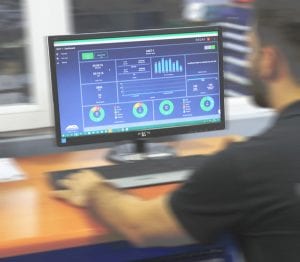 Embrace automation with ANCA’s AR300 loader
Embrace automation with ANCA’s AR300 loader
With over 70% of ANCA customers buying machines with robotic functionality, it’s fair to say the age of the robots has come. Far from a nice-to-have add on, many CNC machines now come with operator panels that provide in-built control over both the grinding software and the robotics function, opening the door to greater automation efficiencies.
At ANCA we provide a complete solution to our customers, designing and manufacturing almost all our technology in-house. As part of this we developed our own low-cost solution for tool loading.
The 3-axes ANCA robot has a capacity of 380 tools and accommodates tool sizes up to Ø20mm (Ø3/4”) x 150mm (6”) long. The AR300 loader is contained within the compact FX Linear machine footprint, so there is no need for extra floorspace. In addition, there is no need to change gripper fingers between batches, which further maximizes productivity.
Utilizing the latest control technology from ANCA Motion, the AR300 loader is an excellent value-for-money auto tool loading solution for the FX5 Linear and FX7 Linear two-wheel changer machines. The loader provides quick tool loading, as the tool is passed directly from the pallet to the collet in a single gripping action.

For further information, please contact:
Sepideh Zandieh
PR and Communications Manager, ANCA
M: +61 439 316 131
Sepideh.Zandieh@anca.com
ANCA is a market leading manufacturer of CNC grinding machines. It was founded in 1974 in Melbourne, Australia where the company still has its global headquarters. ANCA has offices in the UK, Germany, China, Thailand, India, Japan, Brazil and the USA as well as a comprehensive network of representatives and agents worldwide.
ANCA CNC grinders are used for manufacturing precision cutting tools and components across a diverse range of competitive industries including cutting tool manufacture, automotive, aerospace, electronics and medical.
Continue reading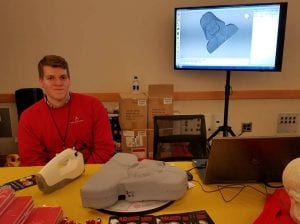 Exact Metrology was present at two career events, one at Northern Kentucky University and the other at Cincinnati State University.
Exact Metrology was present at two career events, one at Northern Kentucky University and the other at Cincinnati State University.
On Wednesday, February 27, Northern Kentucky University held its 2019 Career Expo from 2 to 5 pm. There were 140 employers meeting with students and alumni for internships, co-ops and full-time positions. Employers present came from fields such as: accounting/finance, athletic training and exercise science, math/science/EGT, business, computer science, etc.
Cincinnati State University also held its Career/Co-Op job fair on Thursday, February 28, from 1 to 3 pm. Approximately 40 companies and organizations participated.
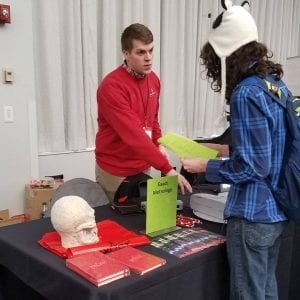 Both events were attended by Matt Martin, the company’s branch manager and an application engineer at Exact Metrology. At these two events, Exact Metrology featured the Artec Eva 3D handheld scanner, from Artec 3D, a world-renowned developer and manufacturer of professional 3D scanners and software. Artec Eva is a handheld scanner ideal for quick, textured and accurate scans. Artec Eva doesn’t require markers or calibration and the scanner captures 16 frames per second. These frames are automatically aligned in real time, making scanning easy and fast. The aim was to foster relationships with these universities, recruit interested students and offer additional tools and information about the company.
Both events were attended by Matt Martin, the company’s branch manager and an application engineer at Exact Metrology. At these two events, Exact Metrology featured the Artec Eva 3D handheld scanner, from Artec 3D, a world-renowned developer and manufacturer of professional 3D scanners and software. Artec Eva is a handheld scanner ideal for quick, textured and accurate scans. Artec Eva doesn’t require markers or calibration and the scanner captures 16 frames per second. These frames are automatically aligned in real time, making scanning easy and fast. The aim was to foster relationships with these universities, recruit interested students and offer additional tools and information about the company.
Exact Metrology, with facilities in Cincinnati and Milwaukee and affiliated offices throughout the Midwest, is a comprehensive metrology services provider, offering customers 3D scanning, reverse engineering, quality inspection, product development and 2D drawings. The company also provides turnkey metrology solutions, including equipment sales and lease/rental arrangements.
Artec 3D is an international company, headquartered in Luxembourg, with subsidiaries in the United States (Santa Clara, California) and Russia (Moscow). Artec develops and produces innovative 3D solutions and products. Artec has a team of professional experts in the collection and processing of 3D surfaces as well as biometric facial recognition. Artec’s products and services can be used in many industries, such as in engineering, medicine, media and design, entertainment, fashion, historic preservation, security technology and more.
For more information, please contact:
Steve Young
Exact Metrology, Inc.
11575 Goldcoast Drive
Cincinnati, OH 45249
Phone: 614-264-8587
Local: 513-831-6620
www.exactmetrology.com
stevey@exactmetrology.com
Systems supplier presents its new blanking press EV 3.8 and other solutions for the efficient production of electric motors and batteries
 The need for greater energy efficiency and the search for alternative energy sources and motors are among the key innovation drivers in industry. Schuler offers various solutions to produce electrical motors and battery cases. At its headquarters in Göppingen, Germany, the systems supplier recently presented its new high-speed blanking press Smartline EV 3.8 for the production of interlocked motor cores, which will be delivered to the German company Waasner, and other solutions for the era of e-mobility. More than 50 people took part in the Schuler TechDay.
The need for greater energy efficiency and the search for alternative energy sources and motors are among the key innovation drivers in industry. Schuler offers various solutions to produce electrical motors and battery cases. At its headquarters in Göppingen, Germany, the systems supplier recently presented its new high-speed blanking press Smartline EV 3.8 for the production of interlocked motor cores, which will be delivered to the German company Waasner, and other solutions for the era of e-mobility. More than 50 people took part in the Schuler TechDay.
Most of the car drivers in the Western hemisphere have probably never heard of the three most successful electric cars in China, — the BAIC EU260 EV, the BAIC EV200 or the SAIC Roewe 550 PHEV. A study published by fka and Roland Berger says that China will manufacture 6.8 million electric cars by 2021, as Schuler’s Rainer Berkefeld pointed out at the company’s TechDay E-Mobility. This is more than the U.S. (3.1), Germany (2.2) and Japan (1.0) combined.
One of the reasons why the rest of the world seems to be so far behind the People’s Republic is that China already has a quota for electric vehicles (EV) of 8% since last year; a long-term goal of 100% is being discussed. Yet, there is a global government push: Germany, the Netherlands and Norway think about a 100% quota by 2030, and France wants to ban the sale of petrol and diesel cars by 2040. “By this time, 35% of cars sold globally will be electric,” Berkefeld said.
E-mobility is growing everywhere, his colleague Simon Schmidt agreed, and has also become a top issue for the car manufacturers. In order to increase the efficiency of the motors, the geometrics of the electric motor lamination have become more and more complex, and as a consequence the dies are getting longer and longer: “Especially because two-row-dies are nowadays state of the art. This is why the table of Schuler’s new high speed blanking press Smartline EV 3.8 now has a length of 3.7 instead of 2.7 meters and can process a strip width of up to 630 mm.”
At the same time, the material thickness has been reduced down to 0.35 mm or even 0.2 mm. “Analyzing the new requests of the automotive industry with regards to e-mobility, the lamination thickness is currently defined at a range of 0.25 mm up to 0.275 mm. Therefore, we as a press supplier have to ensure a perfect positioning and levelling of the slide and table.” Considering this challenge, already 15 years ago Schuler has developed a penetration depth control (PDC) to provide a perfect positioning as well as repeat accuracy of the slide. “This way, we can warrant a perfect punch into the material, whereas we achieve an interlock exactly at the penetration depth. In detail, the Schuler Smartline series is capable of adjusting the PDC at a deviation of 0.01 mm through the entire stroke range.”
Regarding the extended dimensions of the Smartline EV3.8, Schuler was additionally challenged with the physical properties of a 3.7 meter slide. “With the smaller types of the Smartline series, we used to measure with a laser how deep the slide is going down, and the machine corrected the penetration depth, if necessary, within every single stroke automatically. Now, with a 3.7 m slide, there is deflection we have to consider.” For the advanced PDC, Schuler has put a strain gauge into the kiss blocks of the die which substitutes the laser: “Thus, the press force can be kept constant and the deflection of the slide can be controlled. No matter what your laminations look like, you will always get the perfect rotor and stator stacks.”
Schuler’s target was to offer its customers a machine that is reliable, rigid and precise while using the knowledge of building presses for 180 years.
“We can run the full speed of 250 strokes per minute with the full press force of 3,150 kN and the maximum upper die weight of up to six tons,” Schmidt elaborated. The press is harmonized so well there is no need for a special foundation: Customers only have to take care that the foundation can carry the static weight of 110 metric tons. “Thanks to the perfect interaction between static and dynamic counter balance, there is a vertical movement of the press at full speed of less than 1 mm.” As a result, there are no wear parts in the slide guiding, pressure points, connection rods and main bearings, which minimizes the service costs.
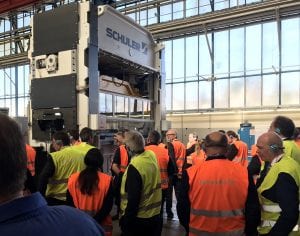
More than 50 people took part in the Schuler TechDay
Although the press is relatively heavy and big, Schuler only uses two instead of three pressure points: “We want to know which press force is exactly on which pressure point, to make sure they are detected to carry this force. With three pressure points, there will always be a small deviation, and it is only a matter of time until you have wear and problems. With two pressure points, the press is physically harmonized because of a predefined press force flow, and the wear is minimized. Another effect is a levelled slide: We can guarantee a parallelism from left to right of 0.04 mm per meter.”
Thanks to the advantages of the new Schuler Smartline EV 3.8 – such as the advanced PDC, a use of two pressure points, four pretensioned slide guidings as well as a perfect interaction of the static and dynamic counter balance – the die lifetime can be increased by up to 30%.
“With high speed steel used as active material, you can do approximately five million strokes in a die lifetime,” Daniel Kittig from die manufacturer Aweba continued. “With Powder Metallurgical, we are talking about roughly 30 million strokes and with carbide almost 180 million strokes, depending on process conditions and material properties.” In most cases, Aweba’s die engineers start with an idea or a drawing they receive from their customers. “Based on that, we are creating a design, taking into account part geometry, size, complexity and tolerances.”
The quantity of the laminations the customer is going to produce is decisive for choosing a single, double or multi row dies, but this also depends on the press capacities and capabilities: “Our goal is to provide the customer a maximum of flexibility. This means that he is able to react on deviations and variations due to the process and material issues. Therefore we integrate features like adjustable inserts.”
Each die has an individual design. Usually, pre-cuts are made in the first steps of the die as well as cut outs to reduce tensions of the stripe material. Next, the shape of the rotor is cut out step by step, a process which is separated in two, three or more different, single stations. “The geometry would be too instable to be combined in just one or two stations,” Kittig explained.
In the following station, the separation sheet for the interlocking operation is punched out pneumatically. The embossing for interlocking the laminations can take place either close to the shaft hole, between the shapes or close to the diameter: “But we also use gluing procedures implemented in our designs.”
“Based on the higher and higher quantities the customers are expecting, we also have layouts for double or multi rows like they perfectly fit on Schuler’s EV 3.8 press”, Kittig said. “Here, we have a better material usage.” He concedes that also for Aweba it is a big challenge to create a die in this length and with this precision: “The accuracy comes down to a few microns all over the die.”
However, the main reason why electric vehicles are still more expensive than cars with an internal combustion engine can be found in the batteries. Thanks to economies of scale, this will change by around 2026: By then, statistics published by Bloomberg show that batteries will account for 24% of the overall costs – compared to 42% in 2018 – and, as a consequence, cars with an electric motor will be financially more attractive than with an internal combustion engine.
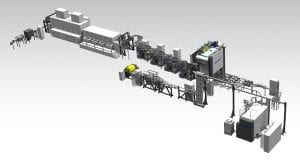
The production line consists of an impact extrusion press (bottom right), a post-processing press, trimmers, washer and dryer
“In today’s electric cars, there are Li-Ion batteries with an overall capacity of 120 GWH”, Schuler’s Rainer Berkefeld said. “This capacity will increase by 2022 to more than 400 GWH, which corresponds to about one billion cell cases which must be manufactured.” According to fka and Roland Berger, China alone will produce cells with a total capacity of 178 GWH between 2016 and 2021, followed by Korea (98 GWH), Japan (87 GWH), the United States of America (74 GWH) and Germany (18 GWH).
More than half of the cases on the market these days are either cylindrical – like in the electric vehicles produced by Tesla – or prismatic, used by Toyota, Mitsubishi, Honda, BMW, VW, Audi, Chrysler, BYD, Ford and others. While cylindrical cells are cheap and commoditized, they need a sophisticated battery management system. Prismatic cells, on the other hand, offer the best scalability and a high cycle life; however, their production is currently still expensive.
“Schuler has developed a fully automated production line for prismatic cells which is not only five times faster than current solutions, but also saves metal,” Berkefeld said, “with standard machines and proven technology that has been used world-wide in the automotive and packaging industry.” The raw material is made of aluminum slugs, which are formed with an impact extrusion press. While the punch is pressing onto the slug, the material flows against the punch travel direction.
After that, the preforms are scanned from both sides in order to detect any cracks or deformation. Those that are out of specifications are blown off the line to prevent a downtime in the subsequent process. In the next step, the preforms are separated into four lanes and fed into the 4-out die of a 300 ton post-processing press. Apart from wall ironing, additional features like fine stepping or calibration can also be integrated.
Then, the cases are fed upside down into the trimmers. The trimming head is working from inside to outside by means of a wobbling movement in order to avoid an inside burr. After the cans have been cleaned and dried, they are ready to use – if they have passed the final vision inspection, that is. The high-speed line is in operation at a major battery manufacturer and can produce more than 30 million cases per year.
Schuler also offers machines for the manufacture of battery lids. They can be produced on a stamping press with a progressive die featuring twelve forming stations, including functions like piercing, trimming, embossing and separating.
Internet
www.schulergroup.com/drives_generators
For further information on Schuler Inc., North America, please contact:
Guido Broder, Vice President of Sales & Marketing
Schuler Incorporated
7145 Commerce Blvd.
Canton, MI 48187 USA
734-207-7200
Guido.Broder@schulergroup.com
About the Schuler Group – www.schulergroup.com
Schuler offers customer-specific cutting-edge technology in all areas of forming technology – from networked presses to press shop planning. In addition to presses, the product portfolio also includes automation and software solutions, dies, process know-how and service for the entire metalworking industry. Its customers include automobile manufacturers and automotive suppliers, as well as companies from the forging, household appliance and electronics industries. Presses from the Schuler Group mint coins for more than 180 countries. As a provider of innovative system solutions, we support our customers worldwide in the digital transformation of forming technology. In the 2018 fiscal year, Schuler generated sales of € 1,212 billion. Schuler AG, founded in 1839 at its headquarters in Göppingen (Germany), has approx. 6,600 employees at production sites in Europe, China and America as well as service companies in over 40 countries. The company is majority-owned by the Austrian ANDRITZ Group.
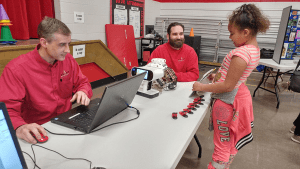
On March 28, 2019, Exact Metrology was among several companies who came to Latonia Elementary Career Day. This event was meant to introduce students to a variety of careers in health, law, manufacturing, engineering, technology and other fields. Fifth grade students spent three weeks researching different careers that interested them. They learned information concerning future salary, education and job skills. Then, students had the opportunity to speak with professionals in their chosen fields and ask questions.
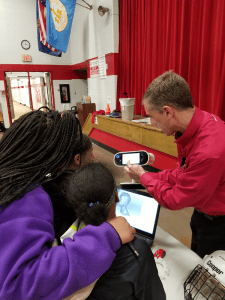 Chris Lafferty, a specialist in Artec 3D’s, professional-grade handheld 3D scanners and software, attended on behalf of Exact Metrology. Together with Jason Kleinhenz, marketing manager at Exact Metrology, they met with students to teach them about metrology using the Artec Leo and Geomagic Design X. Artec Leo is the first 3D scanner to offer onboard automatic processing with an integrated touch panel viewer. This frees users from being tied to a computer for data capture. Users can scan the object and see the 3D replica being built in real time on the screen. The 3D model can be rotated to check that all areas have been captured. The final 3D model can be directly exported to Geomagic Design X.
Chris Lafferty, a specialist in Artec 3D’s, professional-grade handheld 3D scanners and software, attended on behalf of Exact Metrology. Together with Jason Kleinhenz, marketing manager at Exact Metrology, they met with students to teach them about metrology using the Artec Leo and Geomagic Design X. Artec Leo is the first 3D scanner to offer onboard automatic processing with an integrated touch panel viewer. This frees users from being tied to a computer for data capture. Users can scan the object and see the 3D replica being built in real time on the screen. The 3D model can be rotated to check that all areas have been captured. The final 3D model can be directly exported to Geomagic Design X.
Geomagic Design X is the industry’s most comprehensive reverse engineering software-combining history-based CAD with 3D scan data processing and enables users to create feature-based, editable solid models compatible with existing CAD software. Geomagic Design X provides an easy way to integrate CAD models from a 3D scanner into an existing engineering design workflow. This software permits the re-use of designs without manually updating old drawings or re-measure/rebuild a model in CAD.
Jason Kleinhenz commented, “Exact Metrology was happy to participate in this career event because we are committed to giving back by partnering with schools for educational purposes and career enhancements.”

Exact Metrology, with facilities in Cincinnati and Milwaukee and affiliated offices throughout the Midwest, is a comprehensive metrology services provider, offering customers 3D scanning, reverse engineering, quality inspection, product development and 2D drawings. The company also provides turnkey metrology solutions, including equipment sales and lease/rental arrangements.
Artec 3D is an international company, headquartered in Luxembourg, with subsidiaries in the United States (Santa Clara, California) and Russia (Moscow). Artec develops and produces innovative 3D solutions and products. Artec has a team of professional experts in the collection and processing of 3D surfaces as well as biometric facial recognition. Artec’s products and services can be used in many industries, such as in engineering, medicine, media and design, entertainment, fashion, historic preservation, security technology and more.
For more information, please contact:
Steve Young
Exact Metrology, Inc.
11575 Goldcost Drive
Cincinnati, OH 45249
Phone: 614-264-8587
Local: 513-831-6620
www.exactmetrology.com
stevey@exactmetrology.com